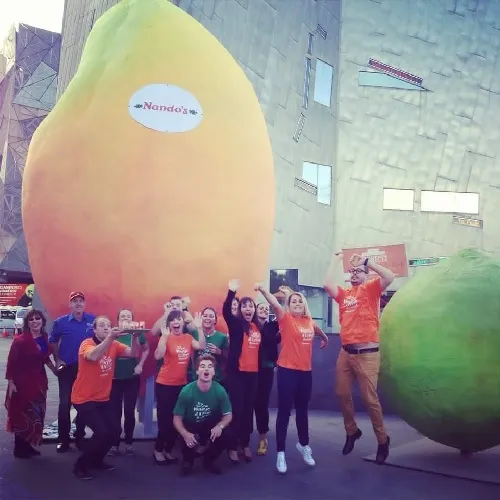
Issue of the month: How to pull off your own mango gate stunt
Here’s the blueprint for outrageous marketing stunts.
Nando’s concocted an elaborate plan to steal the Big Mango, and ended up gaining tons of coverage for its new mango and lime sauce but also left them open for serious customer flak.
Not all brands can and should pull off a “Mango Gate”, according to two brand strategists. But if you ever consider to rock the news headlines with a similarly daring stunt, take time to evaluate whether it will be aligned with your marketing goals and brand equity.
Major considerations before going stunt-crazy
There are four important considerations to decide whether you should include a Mango Gate in your next product launch or promotions campaign, according to Mark Cario, Managing Director at The Marketing Revolution, a retail marketing agency with specialist expertise and experience in local marketing for the retail and franchise industries.
First, consider how the target market will react to such a stunt. “In the case of Nando’s they are aiming to appeal to a younger audience with a positioning that prides itself on being unconventional and irreverent,” said Cario, so the prank of borrowing the Big Mango will likely amuse instead of irritate their target profile.
A Mango Gate-like stunt is also assured to draw all eyes on your product and brand, and that won’t necessarily translate to a warm, friendly connection.
Some may view your stunt negatively and lower you down in their list of preferences.
So for the second consideration, “it is also important to understand the difference between awareness and preference. Just because someone has heard about you; it doesn’t mean that they like you or prefer you,” said Cario.
“Craig Thompson has high awareness at the moment, but I’m not sure if too many people would vote for him. So, you need to ask the question: How will my target customer react to this stunt?” he added.
A third concern is relevance. “How relevant is the stunt to the message you are trying to communicate?” Cario said that in the case of Nando’s, the Big Mango is highly relevant to the new mango and lime menu, which contributes favorably to the stunt.
Finally, brand managers must evaluate the impact of the stunt to the overall objective. “I assume the objective was to generate awareness for the new mango flavour with the target market. If this is the case, then I would say Nando’s one off stunt has been a successful,” said Cario.
In general, if the stunt is tightly aligned to the brand and creates positive dialogue for whatever it is you are trying to push like a service or product, then the stunt should be worth it, said Nigel Patient, Managing Director at Head Mark, a brand and marketing agency.
“The stunt needs to be tightly aligned with your brand. What do you want customers to be saying about you? It also needs to be really easy for people to “get” it. If they have to think too hard about it, you will lose impact and traction,” said Patient.
“It’s great if it becomes a talking point with customers as you will start to create a dialogue. You need to think about how your customer base will react and respond to the stunt though. Will this make them interested in your underlining objective. In the case of Nando’s, will it make customers want to come in and try the new mango and lime sauce or will it just get a laugh? Ultimately you are looking to create top of mind brand awareness and ultimately action.”
Are you bold enough or just reckless?
Even if your brand has an opportunity to pull off a Mango Gate stunt, only take it if you are – or want to be seen – as an innovative brand with edgy marketing campaigns.
“Your organisation needs to be fairly bold, the brand needs to be consistently pushing the boundaries otherwise it comes across as a cheap publicity stunt which doesn’t relate to the brand and just confuses both existing and potential customers. In some cases it could even turn away customers who may value your brand. Again it comes back to what do you want customers to be saying about you?” said Patient.
Cario warns that there is a very thin line between boldness and recklessness, and brands that tip over to the latter because of poor strategy planning will not only waste resources but also damage their long-term positioning.
“If you have decided to do the stunt without giving thought to whether or not it is on strategy, then it is reckless. However, if you have done your homework, then it might not be as ‘bold’ as it appears to people outside the company,” explained Cario.
“All marketing involves some level of risk because there are many factors that are outside your control. Good marketing requires you to minimise your risk and maximise your chances of success by making decisions which are based on a deep understanding of your customers and your position in the market versus your competitors.”























